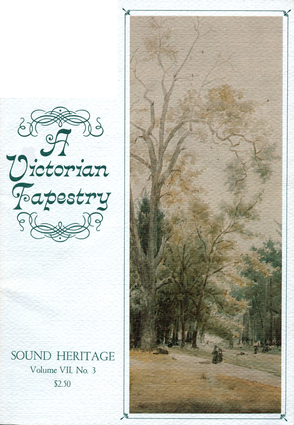Overview
“A Victorian Tapestry” is a compilation of conversational impressions of Victoria, BC, from the 1880s until the First World War. A chronological political and economic history of the city is not to be found here. What is revealed by these reminiscences is the human side of that history: the special people, familiar places, daily rituals, and special events which most impressed a particular group of perceptive and articulate residents of the city. These people were members of Victoria’s economic and social elite and, as such, they expressed the views and described the life style of those who set the tone of life in the city at the turn of the twentieth century. At the same time their observations of the other groups in the city’s population give some insight into their lives, as well as the attitudes of the elite toward the less privileged and ethnically different residents.The period from the 1880s to 1914 was the adolescent phase of Victoria’s development as a city. Its infancy and childhood as a fur-trading port, centre of colonial government and gold-rush supply point had passed. The city was now larger and more diversified in its activities and its population. By 1890, Victoria residents anticipated that their city would soon become a major metropolis—a San Francisco of Canada. The provincial government, the Royal (after 1910, Canadian) Navy establishment, and an assortment of activities related to the forest industry, fishing, sealing, agriculture, and commerce were the focus of a thriving urban life, still somewhat new, rough and unsophisticated and yet displaying features of the most refined and cultivated European society. The depressions of 1893 and 1907 had some minor effects but the real estate boom between 1907 and 1913 brought extravagant growth and the predictable consequences of economic speculation, a kind of last fling of youthful irresponsibility.With the beginning of the First World War, the adolescent phase of the city’s history was over. In the post-war era, cars replaced horses and paved roads replaced lanes, newcomers overwhelmed the original citizenry, and the pre-war social patterns, here as around the world, were forever altered. Victoria settled into a quiet, restrained, and complacent maturity, confidently promoting the useful notion that it had once been, and still was, “a bit of old England.”Like the city itself, the men and women whose recollections are presented here were in an adolescent or youthful phase of their own lives in this period, and their youth gave them a particular perspective on the events of the day which emphasized family life and social events. Some of the recollections were no doubt shaped by the rosy glow of youth as it is perceived by age; others seem starkly realistic, apparently more “accurate” than the rosier views but probably not more so. Yet certain people places and events stood out in the memories and their accounts corroborate each other to a remarkable degree. Together these reminiscences form a rich verbal tapestry portraying Victoria and its people at the turn of the twentieth century.Interviewees include Matilda Alexander, Cecilia Bullen, Flora Hamilton Burns, Victor Casaneve, Emma McLellan, the Honourable Justice Joseph B. Clearihue, Mabel Davis, Walter Englehardt, Winnifred Lugrin Fahey, Kate Ford, Rose Ellen Gillespie, Robert Hiscocks, Helen Hood, Dr. Douglas Hunter, Winnifred Anne Kirkpatrick-Crockett, Major Roger Monteith, Margery Adelaide Muskett, Amelia Paula Pinder, Francis George Pinder, Roberta Elizabeth Robertson, H. C. Scarth, the Honourable Justice Robert A. Wootton, and W. L. B. Young.

